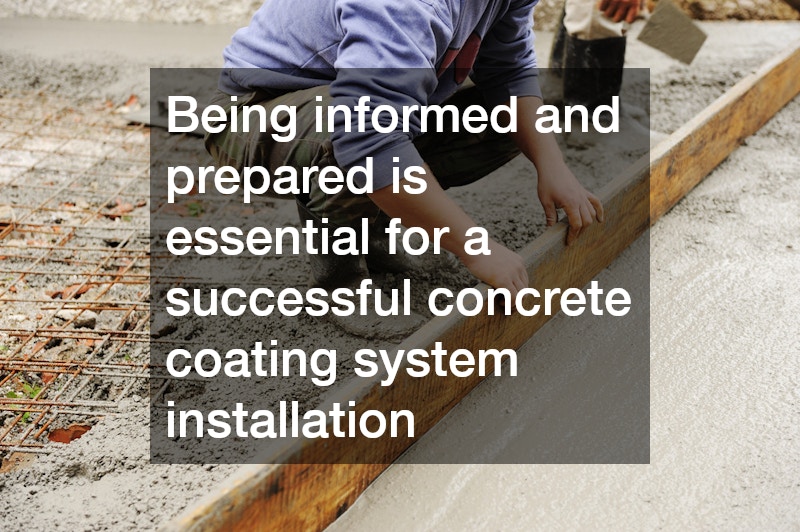Learn the essentials of getting a concrete coating system installed and ensure a successful project by understanding the key factors involved. Concrete surfaces, found in both residential and commercial spaces, are often subject to wear and tear. Their durability can be significantly enhanced through the application of a suitable coating system, making the surface more aesthetically pleasing and robust.
What Is a Surface Treatment for Concrete?
A surface treatment for concrete involves applying a protective layer to enhance durability, extend the life of the material, and improve its overall appearance. These treatments come in a range of material options including epoxy, polyurethane, acrylics, and polyurea, each offering specific advantages like resistance to chemicals, abrasions, moisture, and UV exposure.
One highly effective approach is using a concrete coating system, which provides both functional and aesthetic benefits. Whether you’re looking to create a polished, high-gloss floor or need a textured, anti-slip surface for added safety, coating systems offer versatile solutions to meet a variety of needs. They are commonly used in garages, basements, warehouses, and commercial spaces due to their long-lasting performance and customizable finishes.
Beyond just improving surface strength and appearance, these treatments can also help promote better indoor air quality by sealing the naturally porous surface of concrete, which helps reduce dust. Many modern coatings are available in low-VOC formulations, making them an environmentally friendly choice as well.
How to Choose the Right Coating System?
Choosing the right concrete coating system involves evaluating the specific needs of the surface in question. Factors such as exposure to sunlight, chemicals, moisture, and temperature fluctuations must be considered. For instance, an epoxy coating might be ideal for a garage floor needing high durability and chemical resistance, while acrylics might be suitable for decorative outdoor areas.
Another crucial consideration is the aesthetic appeal. Coating systems come in a spectrum of colors and textures, allowing customization to complement the surrounding décor. Whether you prefer a sleek, glossy finish or a matte, textured look, ensure the chosen system aligns with your design vision while fulfilling the functional requirements.
Budget and maintenance are also pivotal in making an informed decision. While some coatings might be costlier initially, their longevity and low maintenance needs can provide cost savings over time. Comparing warranties and seeking professional advice can further guide you in selecting the most appropriate coating system for your project.
What Preparations are Required Before Installation?
Proper surface preparation is crucial before installing a concrete coating system. This process usually begins with a thorough cleaning of the concrete surface to remove any dirt, oil, or existing coatings that could impede adhesion. Pressure washing and chemical cleaners are often employed to achieve a pristine surface.
After cleaning, surface imperfections such as cracks and holes must be addressed. This may involve filling and sealing these areas with appropriate materials to ensure a smooth, even surface. Grinding or shot blasting might also be necessary to create a texture that promotes optimal adhesion of the coating.
Moisture testing is an essential step to determine the moisture content within the concrete. Excessive moisture levels can cause coatings to fail, so it’s important to ensure that the substrate is adequately dry. Installing a vapor barrier or selecting a moisture-tolerant coating can be solutions in cases of high moisture content.
What to Expect During the Installation Process?
The installation process of a coating system generally follows several stages, beginning with the application of a primer layer. This primer acts as a bonding agent between the concrete and the coating system, enhancing adhesion and sealing the surface. Depending on the system, multiple layers of coating are then applied for thickness and durability.
Techniques for applying coatings can vary, including rolling, brushing, or spraying, each determined by the type of coating and the specific demands of the project. The installation can sometimes emit odors; hence proper ventilation is recommended. Timeframes for drying and curing differ with each coating system so planning for adequate cure time before use is crucial to achieve durability.
Being well-informed and prepared is essential for a successful concrete coating system installation. By understanding the purpose and advantages of these treatments, choosing the right solution, properly preparing the surface, and knowing what to expect during the process, you set the stage for long lasting results.
Learn the essentials of getting a concrete coating system installed and ensure a successful project by understanding the key factors involved. Concrete surfaces, found in both residential and commercial spaces, are often subject to wear and tear. Their durability can be significantly enhanced through the application of a suitable coating system, making the surface more aesthetically pleasing and robust.
What Is a Surface Treatment for Concrete?
A surface treatment for concrete involves applying a protective layer to enhance durability, extend the life of the material, and improve its overall appearance. These treatments come in a range of material options including epoxy, polyurethane, acrylics, and polyurea, each offering specific advantages like resistance to chemicals, abrasions, moisture, and UV exposure.
One highly effective approach is using a concrete coating system, which provides both functional and aesthetic benefits. Whether you’re looking to create a polished, high-gloss floor or need a textured, anti-slip surface for added safety, coating systems offer versatile solutions to meet a variety of needs. They are commonly used in garages, basements, warehouses, and commercial spaces due to their long-lasting performance and customizable finishes.
Beyond just improving surface strength and appearance, these treatments can also help promote better indoor air quality by sealing the naturally porous surface of concrete, which helps reduce dust. Many modern coatings are available in low-VOC formulations, making them an environmentally friendly choice as well.
How to Choose the Right Coating System?
Choosing the right concrete coating system involves evaluating the specific needs of the surface in question. Factors such as exposure to sunlight, chemicals, moisture, and temperature fluctuations must be considered. For instance, an epoxy coating might be ideal for a garage floor needing high durability and chemical resistance, while acrylics might be suitable for decorative outdoor areas.
Another crucial consideration is the aesthetic appeal. Coating systems come in a spectrum of colors and textures, allowing customization to complement the surrounding décor. Whether you prefer a sleek, glossy finish or a matte, textured look, ensure the chosen system aligns with your design vision while fulfilling the functional requirements.
Budget and maintenance are also pivotal in making an informed decision. While some coatings might be costlier initially, their longevity and low maintenance needs can provide cost savings over time. Comparing warranties and seeking professional advice can further guide you in selecting the most appropriate coating system for your project.
What Preparations are Required Before Installation?
Proper surface preparation is crucial before installing a concrete coating system. This process usually begins with a thorough cleaning of the concrete surface to remove any dirt, oil, or existing coatings that could impede adhesion. Pressure washing and chemical cleaners are often employed to achieve a pristine surface.
After cleaning, surface imperfections such as cracks and holes must be addressed. This may involve filling and sealing these areas with appropriate materials to ensure a smooth, even surface. Grinding or shot blasting might also be necessary to create a texture that promotes optimal adhesion of the coating.
Moisture testing is an essential step to determine the moisture content within the concrete. Excessive moisture levels can cause coatings to fail, so it’s important to ensure that the substrate is adequately dry. Installing a vapor barrier or selecting a moisture-tolerant coating can be solutions in cases of high moisture content.
What to Expect During the Installation Process?
The installation process of a coating system generally follows several stages, beginning with the application of a primer layer. This primer acts as a bonding agent between the concrete and the coating system, enhancing adhesion and sealing the surface. Depending on the system, multiple layers of coating are then applied for thickness and durability.
Techniques for applying coatings can vary, including rolling, brushing, or spraying, each determined by the type of coating and the specific demands of the project. The installation can sometimes emit odors; hence proper ventilation is recommended. Timeframes for drying and curing differ with each coating system so planning for adequate cure time before use is crucial to achieve durability.
Being well-informed and prepared is essential for a successful concrete coating system installation. By understanding the purpose and advantages of these treatments, choosing the right solution, properly preparing the surface, and knowing what to expect during the process, you set the stage for long lasting results.

